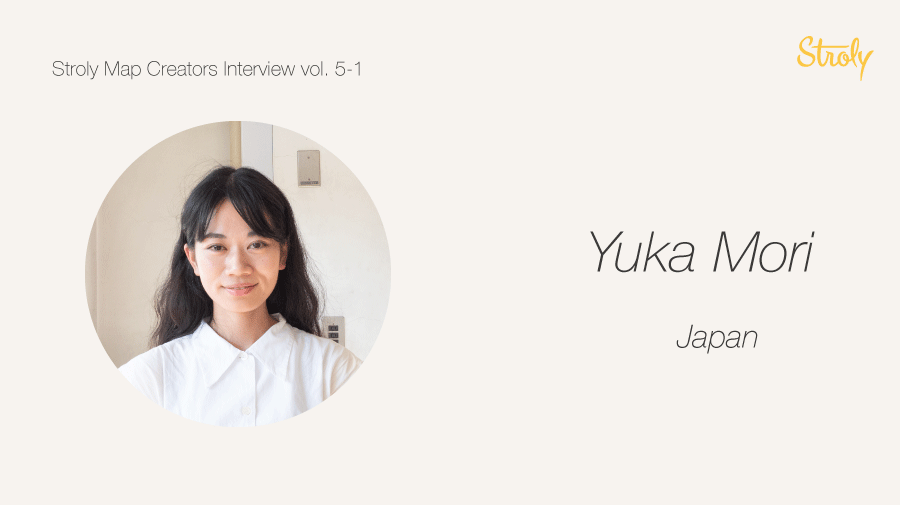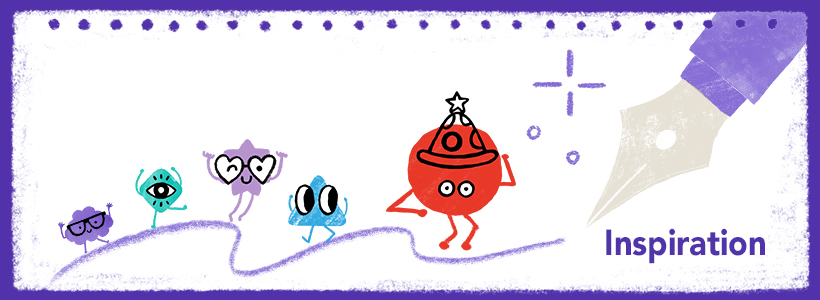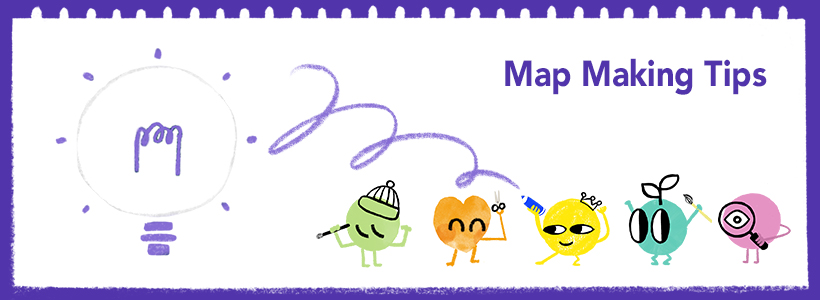In the previous blog post “How A Map Is Created”, I introduced a map creator and illustrator, Ms.Moriyuka, who shared her way of creating an illustrated map. I took the chance to interview her with more in-depth questions this time. We have a long-standing relationship, but this was the first time I asked her about the mindset regarding her work, starting from the technical side to the exciting side.
For now, let me start by sharing with you her story of becoming an Nihonga artist and illustrator.
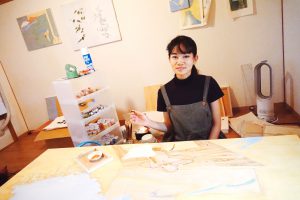
[Art has always been around me. Nothing specific made me start my career.]
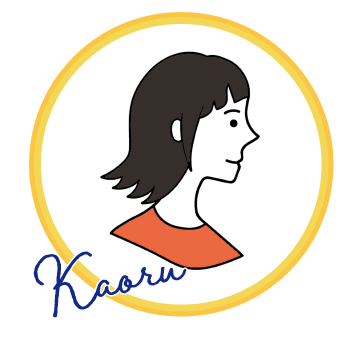 Could you tell me how you developed an interest in art?
Could you tell me how you developed an interest in art?
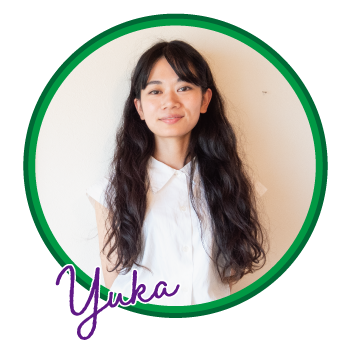
I loved to draw, but I wasn’t a child obsessed with it. My parents are museum lovers, and they used to bring me along. But I couldn’t tell you if it was good or not.
My father is also someone that’s into contemporary art and media. He loves films, so I grew up watching videos with complex themes, long feature films, and experimental films.
That could be the reason why the hurdle for art wasn’t high at all to me. I wasn’t a big fan of art, but it was always around me.
[I was hooked on dancing and fashion in my teens]
 I’ve never would have figured it out! Do you still dance?
I’ve never would have figured it out! Do you still dance?

I still love it, I dance a little bit at home now and then, but I don’t practice for stages anymore. Even though I was really into dance back then, I didn’t see myself as a professional dancer for my career. I kind of knew that I was going to an art university, unlike my older brother, who went to college. My parents were supportive and encouraged me to go to a private school to learn painting, so I started sketching at a relatively early age.

Interesting. Going to the path of art wasn’t something you actively chose, but something you knew that was going to happen in your heart.

I think so. Back then, I knew that I liked to paint, but I didn’t know any professionals around me and couldn’t imagine their lifestyles.
I also was into fashion and design in middle school, and I used to buy this magazine called “Fashion News” very frequently.
I wasn’t interested in ‘buying’ clothes but making clothes on my own. I’m not sure if I had a good sense of fashion, but I studied very hard. I would follow different fashion trends and memorize the designers of the Paris Collection. I was even following the latest models or trends. Lol
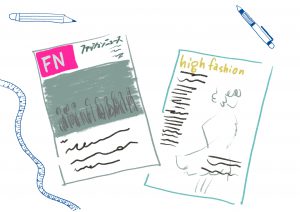
After that, I went to a high school and got addicted to dance, so that’s how my obsession with fashion and design ended. Now that I think of the time spent, I can say that I always admired Art and craftsmanship.
[My Interest in Nihonga (traditional Japanese painting)]

As my high school graduation date got closer, I started attending “OPEN CAMPUS days, where students can freely visit universities. I went to the Kyoto City University of Arts to check out their design course and Nihonga course. Honestly, when I saw some Nihonga sketches in a room where students were practicing drawing, I thought: “This looks boring.”
So, I wasn’t interested in Nihonga at the beginning. I considered going to the design course because it seemed catchy and exciting. Still, it wasn’t cool enough to attract me. I’d spent days and days pondering which direction to take: Nihonga, design, or even oil painting.
Around that time, some artists were introducing a “Modern Nihonga” movement using traditional Japanese painting techniques, which started getting popular. Because of that, I began to reconsider taking the Nihonga course, so I took the exam. That was how I got into that university.
 Wow, so you weren’t determined to be a Nihonga artist since the beginning!?
Wow, so you weren’t determined to be a Nihonga artist since the beginning!?
 Not at all. I didn’t know any famous Nihonga artists back then. Maybe Ito Jakuchu only, Lol.
Not at all. I didn’t know any famous Nihonga artists back then. Maybe Ito Jakuchu only, Lol.
[My University Days]

So, you trusted your guts and decided to take the path on becoming a Nihonga artist. I see you made the decision on your own and didn’t get influenced by others. How about after entering university? Any influences there?

There were so many. If I need to explain what Nihonga is, I’d say what we call the iconic paintings that have been in Japan since the old days. We started calling it “Nihonga” to differentiate Western paintings and Japanese paintings during the Modern period. So, for example, very typical Nihonga like the Kanō school paintings were called just “paintings” before that period.
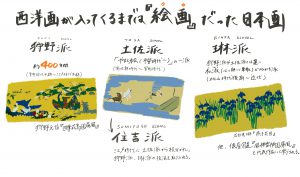
Then, there was a movement to encourage artists to use Nihonga styles. Some used Nihonga themes and combined them with different styles, for example, very thick layers of oil paintings. I enjoy classical Nihonga, and I had a particular image of how Nihonga should be.
Maybe because of that, these new styles didn’t attract me.
As I said, I used to watch videos and films with my dad, so I feel I’ve been close to art all my life. But, I found myself not being serious about Nihonga art at first and not even trying to understand it even though it was my major.
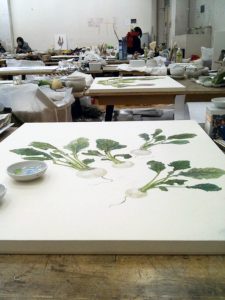

I can relate to the story. I like photography, but I’m also interested in filmings, music, and painting. Among them, photography fits me the most, so I chose to be a photographer. I may be wrong, but I feel that you took the Nihonga course in the same way as I did. It attracted you the most compared to the others, so you have Nihonga, let’s say, as your base or root, and as branches, you have other influences or interests. They grow and expand regardless of your style.

Yeah, you have a point. I like dancing and hip-hop. I kept going to dance workshops in my university days, and I even started learning ballet because I wanted to learn the root of dance. With ballet, many things started making sense. Then I thought, “I’m not interested in being a dancer, but I want to express the body movement in my art. Later, I hit a wall again when I was figuring out what object I wanted to use, but things started connecting each other.
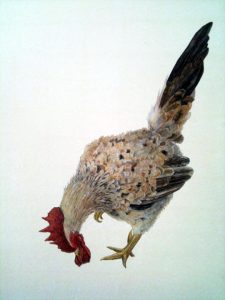
While I spent my days pondering that, I had been working on assignments to draw animals for one of my Nihonga classes. Using the same animal, I started drawing a simpler and cuter version of it on postcard-sized paper. I also drew, for example, a monkey, a rabbit, or a rooster in Chōjū-giga style. That is when I started using two names 森夕香(Mori Yuka in Kanji characters) for Nihonga and もりゆか(Moriyuka in Hiragana characters) for illustrations.
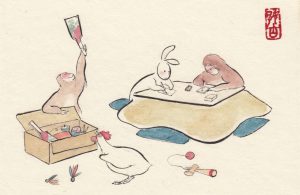
[Two Moriyuka]

So that’s the beginning of two Moriyukas, then!
Previously, you told me that Nihonga is a way of expressing yourself, and drawing illustrations is more goal-oriented work. I imagine that it could be tough if you keep working on Nihonga only and not expressing yourself consistently. How do you use illustrations in those moments?

Drawing an illustration can be doubting at the rough sketch stage, even if it’s just a map. Still, once I start finishing up with ink, it becomes a series of tasks to complete.
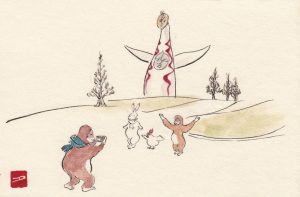
During the process, I try to empty my mind as much as I can. I forget about anything bothering me and just focus on the work in front of me. The way I think is, drawing an illustration is the closest to a small task like washing dishes. Still, I really need it regularly because I love the feeling I get, and it’s a very important activity that can’t be missed from my daily routine.

 It sounds like an exercise to me. If you don’t work out, you get stressed out quickly.
It sounds like an exercise to me. If you don’t work out, you get stressed out quickly.

Absolutely. For illustrations, I think thoroughly to create rough sketches and make a good draft, but the moment I grab my Ink brush, I get ready to focus. I have pretty clear ideas about what I want to work on for each process. On the other hand, Nihonga requires a lot of thinking, and often I find myself getting exhausted even though sometimes I can get in the zone too.
 I’m going to bring more requests of illustrated maps to relieve the lack of exercise, then!
I’m going to bring more requests of illustrated maps to relieve the lack of exercise, then!

Please do so! I can work out and keep my emotions stable. Isn’t it great that people can see my work as a tangible object, experience it, and leave comments on it?
 I agree! Illustrations can be a result of work, but it can make people happy.
I agree! Illustrations can be a result of work, but it can make people happy.
 Totally! When I say it out loud, it feels so good. Lol
Totally! When I say it out loud, it feels so good. Lol

I heard that the “Fukakusa Inari town map” you made has many views, and the users are exercising by walking around the area with the map.
 I’m glad that people are using the result of our exercises, and we are supporting their health too!
I’m glad that people are using the result of our exercises, and we are supporting their health too!

I feel fantastic when I check the analytics of my map showing that they are using it, and not just looking at it. The next project has been planned already, and I’m looking forward to it.
 I’m happy to be able to work on the next project too.
I’m happy to be able to work on the next project too.
[Inspiration comes from atmosphere, scent, and humidity]
 The next question, where do you get inspiration for your art?
The next question, where do you get inspiration for your art?

I want to share the mood, the scent, or how my body experiences things into my artworks. For example, I want to draw the sense I get when I dance. I also like to find a way to express things that you can’t see visually but can sense, like our atmosphere, scent, or humidity.
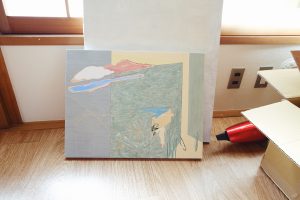
 Could you tell me more about that?
Could you tell me more about that?

Of course. For example, I love summer. You know, it’s hot and humid, and we sweat crazy even when you are just sitting. Food gets bad quickly, and water gets evaporated. It’s a season you feel things around you continually changing. In contrast, winter is a season when everything freezes and doesn’t see the changes much.
I like the feelings I get when I sweat. My throat gets dried quickly, and when I drink water, it gets refreshed so instantly. I want to visualize and express the changes I’m going through in my art.
I can’t include everything in illustrations, but when I paint, that’s something I think about. I can get inspired by anything around me, but I mostly get inspiration from the feelings I get.


That’s a unique point of view. I’ve never thought of getting inspiration from temperature or humidity. In Japanese, we have several words to describe humidity, like “Mushimushi” (hot and humid) or “Jimejime” (hot and damp). These are onomatopoeia, so it never occurred to me to express it in art. But for painters, it’s possible because you have the skills to visualize them.

I still have a lot to learn. Here, let me show you one of my favorite Japanese picture books named “A little boy Enso taking a choo-choo train”. I love it because you can feel the sense of humidity and sweat after reading it.
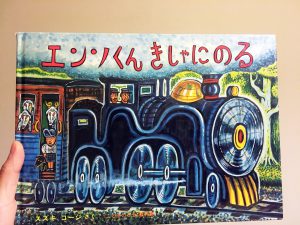
Author: Sizukiko-ji
The front page of “A little boy Enso taking choo-choo train”
The story is straightforward. It’s about a little boy named Enso that goes to see his grandpa by taking a choo-choo train. There is a page that describes the time when a shepherd gets on the train with many sheep. Then, the sheep and Enso eat lunch on the train. I can’t explain why, but when I see this page, I can almost smell the hay or the sheep. I’m amazed that there’s no description of it being “hot” or “humid”, but the picture can give you a sense of how sweaty and smelly the train is. Maybe I can’t reach this level of presenting the exact smell, but I always want to challenge myself to express the sense I get as much as I can.

Arthor: Sizukiko-ji
The page of “taking a nap”
[My dream as an illustrator and as an artist]
 After hearing all this, the way I see your drawing changed. Now, what is your dream as an illustrator and as an artist?
After hearing all this, the way I see your drawing changed. Now, what is your dream as an illustrator and as an artist?

As an illustrator, it’s crystal clear. I want to be able to draw faithfully what my clients wish and contribute to the process of making people happy. Then, I want to see my works in magazines or advertisements too. Lol.
As an artist, I want to appeal to the audience’s synesthesia by expressing the world we are not perceiving. I think this could make them feel relieved.
 Can you break it down for me why it can make people feel relieved?
Can you break it down for me why it can make people feel relieved?

I think there are many things that we perceive, but the way we see is not quite the same in reality because each of our brains is controlling how we see, hear, or feel the world. I see the world in one way, but others are looking at the same thing completely differently. I want to dig more about this.
For example, my skin is the border between my body and the world around me. But, I sometimes think it’s not true. I feel like we are all connected with things around us. When I found out the idea, I felt very relieved.
 Would you be able to explain a little more what happened during the process of reaching the sense of security?
Would you be able to explain a little more what happened during the process of reaching the sense of security?

There was a time when I hated the fact that I would never be able to get out of my body. I didn’t have a complaint about my appearance, but it was shocking and sad, and I was depressed.
Then, I realized that if I change my mindset, the way I see the world would change too. I reached the idea that my brain is making me believe that my body is separated from others. Still, there is a possibility that it’s not true because my mind can be just tricking me.
I also found some articles stating similar ideas.
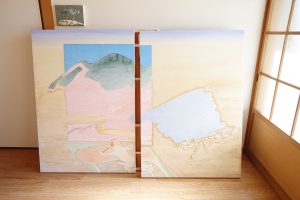
Before, I couldn’t tell what message I wanted to deliver through my art. Still, it made sense when I found out that I’d be so happy if some people can get away from the idea that discourages them by looking at my art. So, my goal as an artist is to express something I can appeal to people’s feelings that can change their perspectives and give a sense of ease. If they pay me for the art, that would be the best. Lol.

As an artist, “making money out of your work” is essential because it’s not always easy to have someone like your art and get purchased. I hope this interview reveals who you are and let the world know the charms of you.
 Thank you! I’m ready to open up and talk more, Lol.
Thank you! I’m ready to open up and talk more, Lol.
[The startpoint of map making was a picture book competition]
 Alright then, could you tell me how you started to draw illustrated maps?
Alright then, could you tell me how you started to draw illustrated maps?

I think it was when I was in the third year of my university. I found a competition for a new picture book artist hosted by a magazine called “moe”. I loved picture books and the magazine, so I decided to submit my work using the Chōjū-giga style animal characters I created.
 Could you tell me the story of the picture book?
Could you tell me the story of the picture book?

It was about my hometown where my junior school and high school are. It’s located at the foot of Mt. Hiei, which has a rich history and traditional atmosphere. I remember I always felt happy to see so much green when I used to go to school, and I had a sense of pride that I am studying in such a beautiful place. I always wanted to make a picture book about the place if I had a chance, so I drew 11 pictures and created a story that went along with it.
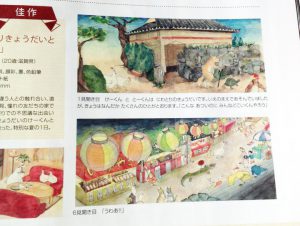
I got a small prize for fine work, and the editor of the magazine offered me two pages of the magazine to present a short story and illustrations.
[After the competition]
The editor and I took some time to decide the theme because we wanted to use the cuteness the characters have effectively. In the end, we decided to make two pages of a bird-eye style map in the way that a monkey and a rooster stroll around and introduce one of the famous touristic areas in Kyoto. This became my first map-like illustration.
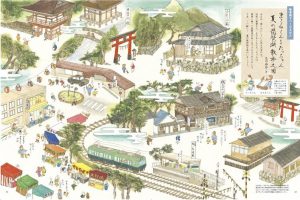
Lake Biwa in summer with Masaru-kun and Tac-chan

Onsen in winter with Masaru-kun and Tac-chan

Did Mr.Yamada from Tadahonya know this? Did he invite you to one of the Stroly workshops, MAP CAFE, because of the magazine?

Exactly. Mr. Yamada knew me and my style from the magazine. It was the only work you could see in public. I was drawing only buildings and sceneries, and not many illustrated maps before I started working with Stroly.
A map created in a workshop, MAP CAFE “Sakamoto to Demachiyanagi girl’s train trip.”
・・・
The interview continues in the second part.
Check the following for the latest information of Ms.Moriyuka!
Instagram、Website

